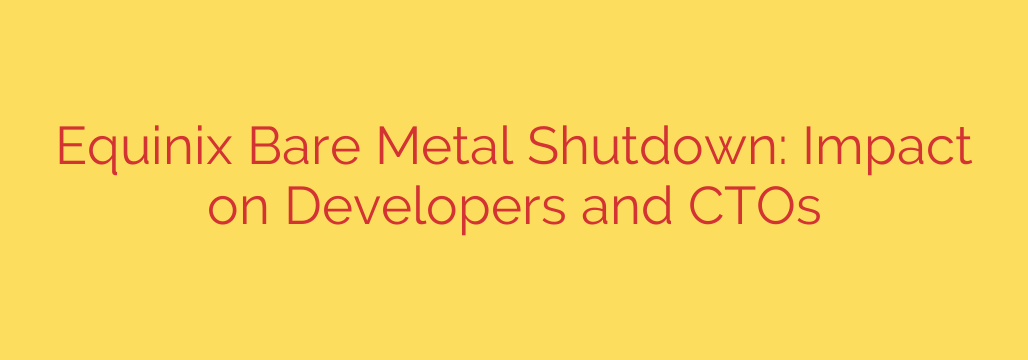
The Equinix Metal Shutdown: A CTO’s Guide to Navigating the Transition
Recent news has confirmed that Equinix is sunsetting its popular bare metal service, a move sending ripples through the tech community. For Chief Technology Officers (CTOs), engineering leads, and developers who rely on this powerful infrastructure, this announcement triggers a critical period of evaluation and migration.
While disruptive, this change also presents a strategic opportunity to reassess your infrastructure, optimize costs, and align your technology stack with future goals. This guide breaks down the impact of the shutdown and provides a clear, actionable roadmap for navigating your next steps.
Understanding the Impact: More Than Just Moving Servers
The discontinuation of a core infrastructure service is never a simple matter. The impact extends beyond simply finding a new provider.
- Forced Migration is Now a Priority: The primary consequence is the need for a mandatory migration. This isn’t a “when” but a “how soon” scenario. Teams must now allocate significant engineering resources to plan, test, and execute a move to a new platform, all while maintaining service uptime.
- A Moment to Re-evaluate Your Core Needs: Does your application still require the raw performance of dedicated bare metal? This shutdown forces a valuable question: Is there a better-suited or more cost-effective solution available now? This could mean moving to another bare metal provider, exploring high-performance virtualized environments, or even leveraging hyperscale cloud services.
- Potential for Cost and Performance Optimization: Migrating your infrastructure is a chance for a clean slate. You can shed underutilized resources, right-size your instances based on current performance data, and potentially find a provider with a more favorable pricing model for your specific workload.
Your Migration Roadmap: Exploring the Alternatives
With the Equinix Metal platform winding down, the market offers several robust alternatives. The right choice depends entirely on your specific requirements for performance, control, scalability, and budget.
1. Dedicated Bare Metal Providers
For those who need to maintain the same level of performance and single-tenant architecture, several strong competitors exist. Providers like Vultr, Hetzner, and OVHcloud offer a wide range of dedicated server configurations, often at highly competitive price points.
- Best for: Workloads requiring maximum CPU/GPU performance, consistent I/O, and complete control over the hardware and software stack. This is the most direct replacement for the Equinix Metal service.
2. Bare Metal Solutions from Hyperscalers
Major cloud providers offer their own bare metal instances, combining the power of dedicated hardware with the flexibility and rich ecosystem of the cloud.
- AWS: EC2 Bare Metal instances provide direct access to the processor and memory of the underlying server.
- Google Cloud: Bare Metal Solution offers hardware for specialized workloads with seamless integration to other Google Cloud services.
- Azure: Provides dedicated hosts and large instance sizes for high-performance computing needs.
- Best for: Organizations already invested in a specific cloud ecosystem or those needing to run specialized applications (like Oracle databases or SAP) that require dedicated, certified hardware alongside cloud-native services.
3. High-Performance Virtual Machines (VMs)
Modern virtualization technology has come a long way. For many applications, the performance gap between bare metal and high-end VMs has narrowed significantly. Exploring compute-optimized or memory-optimized VMs on a major cloud platform could offer a “good enough” performance profile with added benefits.
- Best for: Applications that are not strictly dependent on single-tenant hardware and can benefit from the flexibility, auto-scaling, and managed services of a cloud environment.
An Actionable 5-Step Migration Plan
A successful transition requires a methodical approach. Rushing the process can lead to costly downtime and performance issues. Follow these steps for a smooth and secure migration.
Audit Your Current Environment: Before you move, you need a complete inventory. Document every server, its configuration (CPU, RAM, storage), network dependencies, and the specific applications it runs. This audit is the foundation of your entire migration plan.
Define Your Non-Negotiable Requirements: Use your audit to create a checklist. What are your absolute needs? Is it a specific CPU architecture? GPU availability? A certain level of network throughput? Low latency to specific regions? This list will be your guide when evaluating new providers.
Benchmark Potential Providers: Don’t rely on marketing materials alone. Shortlist 2-3 potential providers and run real-world performance benchmarks. Test CPU performance, disk I/O, and network speed using tools and workloads that mimic your actual production environment.
Develop a Phased Migration Strategy: Avoid a “big bang” migration where you move everything at once. Start with less critical systems, like staging or development environments. This allows your team to familiarize themselves with the new platform and iron out any issues before touching production workloads.
Prioritize Security Throughout the Process: Migration is a sensitive operation. Ensure all data is encrypted both in transit (while moving) and at rest (on the new provider’s storage). Implement strict access controls, rotate credentials after the migration, and conduct a thorough security review of the new environment before decommissioning your old servers.
While unexpected infrastructure changes are challenging, they are also a catalyst for progress. By approaching the Equinix Metal shutdown with a clear and strategic plan, you can ensure a seamless transition, strengthen your infrastructure, and position your organization for future success.
Source: https://www.redswitches.com/blog/equinix-bare-metals-shutdown/








